I loved being with my grandmother. She was a stern lady, truly stubborn at times, but a caring, very happy and self-assured woman who seemed to enjoy every day of her life. Back in 1910, by some kind of premonition, my great-grandparents named her Áurea. For those not familiar with the word, it means “golden, or relative to gold”. And for 97 years she lived up to her name! I can’t help but smile every time I remember her laughter.
I was still very small when she taught me one of my favorite jokes: a Portuguese guy entered a room and, dumbfounded, he saw his friend trying to hammer the wrong end of a nail into a brick wall. More perceptive and astute, he promptly offered a piece of his own wisdom “Stop immediately, you fool, can’t you see that the nail you are helplessly hammering on is for the opposite wall?” My childhood friends and I would crack up laughing at the silliness of it. Grandma Áurea was of Portuguese descent from both sides of her family, so please don’t interpret her as discriminating and politically-incorrect.
Sometime ago I read a post on monetary policies that reminded me of my cheerful granny. The writer was saying that, when Central Bankers have nothing but a hammer in their hands, EVERYTHING begins to look like nails to them!
When it comes to the unorthodox economy of our estranged times, we all hammer some opinions, offering a piece of our own mind. And we can only hope time will prove us right…
Since August of last year, when I wrote that crude oil could not count on fundamentals to support prices anywhere near the $100 dollar per barrel mark, I have been advocating that the Fed is trapped in terms of low Federal Funds rates, without much chance of any rate hike. And indeed, I had explored this concept further in other texts, betting on the long end of the yield curve. It has played out, so far. But some headwinds are starting to blow.
For those who carefully read my early December 2014 post (here) my words were already hinting that appreciation of the dollar and lower inflation numbers would soon urge the Federal Reserve to further swell its balance sheet. In plain English, that means more money printing. The problem was that the lack of any sustainability of results from the Fed’s own very recent efforts (and those of the more desperate Bank of Japan) were bound to hold American printers at bay for some time, temporarily depriving the economy from the clutches of Quantitative Easing. Keep in mind that I wrote on this matter just a few weeks after they had finally ended a two-year QE program – the longest and most expensive of all QE editions (so far).
At that time, the latest inflation release by the Bureau of Labor Statistics was for 1.66% for the 12-month period ended in October 2014. To back up my bet of lower inflation and no interest rate hike, I offered data on the relative yields of the bond market, the US Dollar Index, demographics and M1 money multiplier. All of them pointed to no interest rate hike by the FOMC in the foreseeable future. As a matter of fact, if adopting the standard Bernanke/Yellen frame of mind, all except the latter (M1 money multiplier) seemed to steer the Fed towards more QE.
The illustration below seems to defy our common sense. Almost four TRILLION printed dollars later, US inflation fell flat on its face again (to use the exact same expression I wrote on that previous oil text).
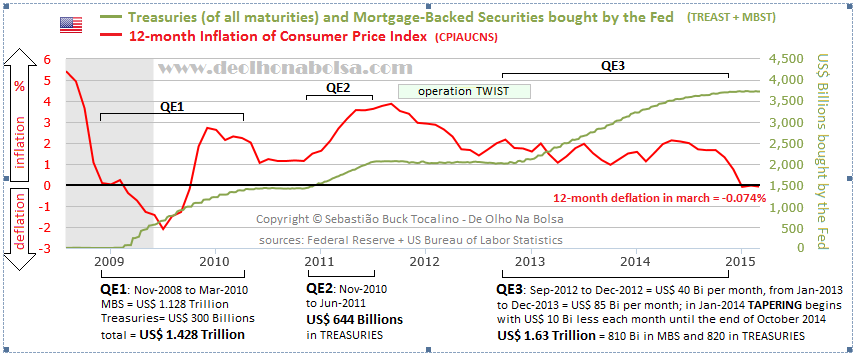
After seeing that oil prices were finally being checked by fundamentals, I started to worry about the speed of that fall in terms of its side effects, like the destruction of many of the best-paid jobs in post-global-financial-crisis America, the corporate debt market, the resilience of their creditors and, again, the financial system as a whole. Mind that price-deflation and debt-inflation are a dangerous mix that can trigger defaults.

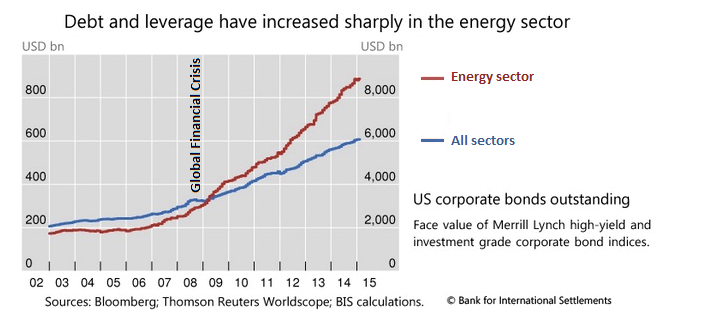
Everything is so intertwined, that this reality bite on crude may feed back into other economic and geopolitical issues. And US crude stocks are building up in storage. At some point, they will be dumped on the market, resulting in more tumbling prices, lower inflation numbers, a stronger dollar and the lesser likelihood of rate hikes…
The oil market is hooked on negative real interest rates. But what kept the Fed Funds rate in negative territory in real terms was just QE. Without that generous stream of new dollars, though very low in nominal terms, the 0 to 0.25% range still offers positive yields once disinflation and deflation are allowed to play out.
Oil happens to be a junkie on negative real interest rates, which is a junkie on inflation, which is a junkie on new dollars. They are all looking for another fix, and the Central Bank is the dealer running the streets.
But still, though now not nearly as loudly or broadly as some months ago, I hear the town-criers and heralds of imminent rate hikes and a terrible bubble-bust on US Treasury Bonds and the longer specter of the bond market. Someone must have got it wrong, either me or them. So bear with me a little longer and feel free to write later offering me your own views. I welcome the discussion. But in my view, even if the Fed sentences all junkies to go cold turkey, allowing no additional QE fixes to anyone, the unavoidable abstinence syndrome will be harsh and painful. That still puts a rate hike out of the picture for a long while.
Therefore, the issue for me is not if rate hikes by the FOMC will materialize anytime soon, but indeed if the Fed isn’t going to be hard pressed against the wall with demands for more quantitative easing. Especially from the oil sector. A stronger pullback on the US Dollar Index could signal that the market is already pricing in more monetary stimulus with a new edition of QE.

The dead-cat bounce of oil also seems to be pricing in some new dollars soon to be sprinkled on the market.
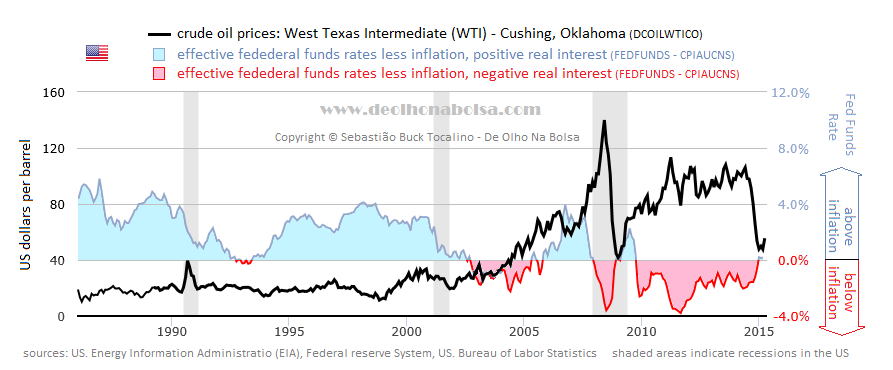
But that’s not all. Total margin debt at the New York Stock Exchange has just set another record high, at $ 476 billion dollars. That also points to expectations of further QE. I do believe margin debt is likely to spike up higher and closer to $550B. That shouldn’t be too hard with some help from the printing presses. In the last two stock-market reversals (of 2000 and 2007) margin debt soared much more steeply for several months before the heavy betters started to delever on stocks.
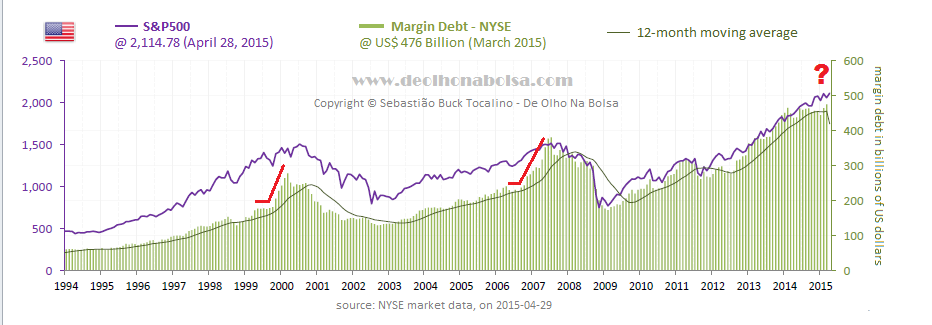
The Fed may also not resist the temptation to scoop up yet another load of US Treasury Bonds. If this doesn’t make sense to you, let me draw a picture: Japan has been busy lately, buying more US Treasuries. It just seized back the title of the greatest foreign holder of US Treasuries, a position once stolen by China.
China has been busy diversifying its investments in different countries and different currencies. Some may find it wise. I find it rather bold, since these economies are based on commodity exports. These are still connected to US dollars. And Uncle Sam is still in charge of its own still-powerful currency. If new dollars stop dripping into markets, commodities will tumble further and the greenback will rule higher. It is just a matter of when they will stop printing, which I don’t think will happen yet, but the day will eventually come. China will feel forced to buy Treasuries again, just like Japan did and Europe will. They will need to weaken their own currency against the US dollar. When that happens, the Fed will have most of those Treasuries, suddenly back en vogue again. And very likely the long end of the yield curve in the US will be lower, so foreign buyers will pay more for these bonds, inflating their prices even higher. That will be the time to watch out for a bubbly bond market!
So the Fed, once again, may make a profit – as it did when we all (myself included) thought that those federal bailouts were just a waste of public money back in 2008/2009 (check it out).
As Peter Tchir showed in the table below, around the end of last QE, the Fed already owned more than half of the Treasuries maturing between 10-15 years and 45.4% of the longest T-Bonds, with maturities greater than 20 years. It actually held 45.87% of all Treasuries with maturities greater than 10 years!
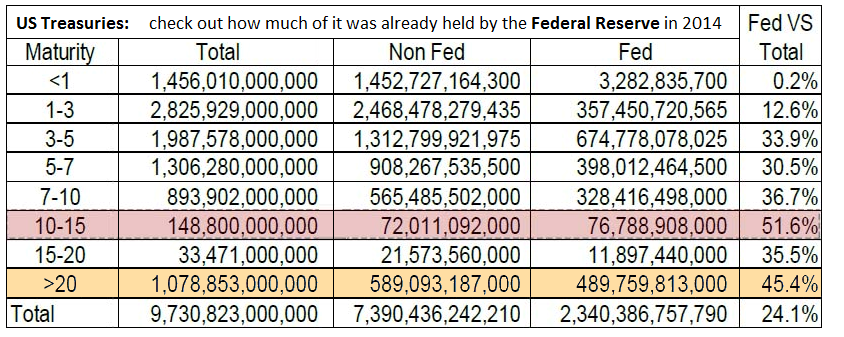
The next chart shows some ETFs based on US Treasuries of different maturities (iShares 20+ Year Treasury Bond (ARCA:TLT), iShares 7-10 Year Treasury Bond (ARCA:IEF), iShares 1-3 Year Treasury Bond (ARCA:SHY), iShares 10-20 Year Treasury Bond (NYSE:TLH) and iShares 3-7 Year Treasury Bond (ARCA:IEI)) and their appreciation (%) since their trading inception date. Notice that previous periods without QE have culminated in large discrepancies among these ETFs (like the one presently underway), but all three previous editions of QE have markedly pushed their prices back down, making them cheaper and placing them in a much closer range relative to one another at the end of each QE. Except for the tapering of QE3, during 2014, whenever its printing presses are running, the Fed finds itself buying US T-Bonds and T-Notes progressively cheaper and with higher paying yields.
The chart below does not show yields, but, as we know, they move opposite to the underlying bond prices.
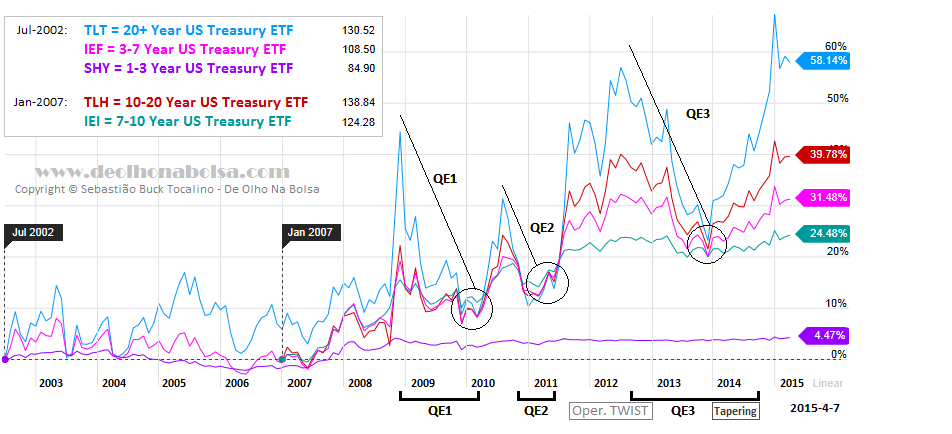
If those previous patterns hold true through yet another round of QE, long-bond holders may see the punch bowl taken away from them. That’s bad in the short run, but there will be better bargains for those that play along with the Fed.
Lots of people worry that they will have a hard time unwinding these policies in the future, but this asset buying policy may actually turn out to be lucrative.
If China capitulates later and the Federal Reserve plays its cards well, these securities may be sold for some handsome profit in the years ahead. I believe that sooner or later China will need to reconsider. They will face a huge demographic problem once the number of Chinese youth decrease versus their seniors. Trying to push greater domestic consumption a few years from now, when China’s aging population are finally over the hill, sounds like a wild bet to me.
Just look at what happened to Japan in the 1990s. And it is worth remembering that Japan never had any history of a one-child-per-family government policy. But still, Japan’s population is shrinking. Germany, Italy and some other European nations are irremediably following on the same demographic footsteps of Japan. So the USA, with much better demographics, will remain the best developed market for Chinese exports. The Asian giant will have to further devalue the yuan and make their products yet more attractive for trading in dollar terms.
I would like to clarify now that these policies are not necessarily something I endorse. As a matter of fact, I am very critical of this Keynesian panacea and all the slack regulation and policies that got us in this mess in the first place. But I am an investor and not a policy-maker. My business is that of trying to make some money by figuring what lurks around the corner and how central bankers will deal with it. So if you don’t like the message, please don’t shoot the messenger.
And remember what your parents taught you when you were still very small: always look both ways before you cross the street. Especially Wall Street. For those looking just one way (to the diversion of rate hikes), I recommend reading “Lessons from the U.S. Experience with QE” released on February 5, 2015, by the Federal Reserve Bank of Boston.
Again I emphasize that I do not advocate these policies. But, regardless of my personal approval or disapproval, I have to keep working. When someone else is choosing the tune in the jukebox, we just try to dance to that beat the best we can.
